Catholic University Receives War News Calmly
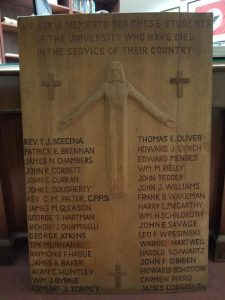
So reads the main headline of the December 12, 1941 Tower — the first issue of the Catholic University student newspaper published after the December 7 attack on Pearl Harbor. But reading into the article it headlines, and the many articles and letters that are in this same issue, one finds a variety of emotions on display beyond just “calm.” Many members of the campus community expressed fear and anger, patriotism, or even disinterest. This particular issue is a symphony of emotions and uncertainty. Students, faculty, and staff report hopes for peace, desire for revenge, or even attempts at making jokes. Columns advocated for a quick response by the college student to the crisis facing the nation and world. Rumors swirled about what would happen. The uncertainty about the length and severity of the conflict, or even if universities would be able to continue operating the same way in the short- or long-term weighed on many minds in December 1941 and in the months and years ahead.
In hindsight, it is easy to assume that everyone understood what was happening at the time and shared in a collective response. The hindsight of history has provided us with a perspective of the days and weeks following the US entry into World War II that can be uniform and seem well-planned, with every person and institution on the same page. But people and history are seldom so simple and clear-cut. And looking through the student-led Tower during the war years reveals the anxieties, hope, adjustments, and ultimate triumph of the campus community in the face of a global challenge.
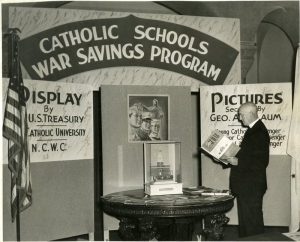
To better understand their place and how their university may respond, students turned to the last major global conflict — World War I. The Tower reports efforts to understand how campus offices functioned and how groups such as the “Student Army Training Corps” operated at the time. Articles reflect on students enlisting and highlighted the way students rallied both to the nation and to the campus during the “Great War.” The paper also took pride in highlighting the service of WWI veterans among the current faculty and alumni community. In its column “C. U. Men of Yesteryear,” the focus shifted from job promotions and weddings to reporting largely on military enlistments. In the August 20, 1943 issue, the Tower casually reported on Class of 1912 alumni:
Major-General Terry Allen, who so successfully commanded the first U.S. Infantry Division in North Africa, is currently leading the same outfit in the Sicily Campaign.
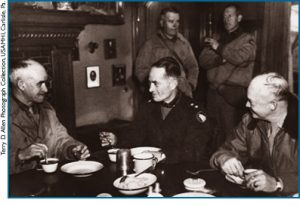
But it was not all focused on the war fronts, as campus life did continue. Changes to college life during the war years were anticipated, with a November 1942 Tower article discussing rumors about changing academic calendars, adjustments to how classes may be taught, and even shifting commencement dates. As the author put it:
It indicated that the men in charge of the war effort, having solved the major problems connected with transferring the processes of civilian life to the methods of total war, were coming round to putting an end to the difficulties of the position of the colleges in war time.
As the war continued throughout the early 1940s, material and demographic changes occurred on campus. In addition to some dances and social gatherings, USO training sessions were held and military exercises occurred on campus. Publications like the Cardinal Yearbook were suspended from 1944-1947, and more women were able to enroll on campus.
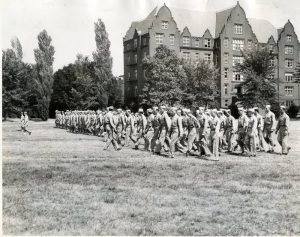
As recounted in an earlier blog, the admittance of women to Catholic University was still relatively new and often limited to programs in the School of Nursing. But with so many male students enlisting, women began to take more active roles on the campus. In early 1943, for example, nine School of Nursing students joined the Tower staff as its first women members. But these writers were not merely replacements meant to keep the newspaper afloat, they were active agents shaping the future of the campus.
Among the nine writers, columnist and member of the Tower business staff Margaret Clarke ‘44, wrote:
It seems that throughout history women are facing some form of competition, some barrier, some challenge. Just in the past World War I days the women of the entire nation faced a challenge when they tried to gain the legal right to vote. But they overcame this challenge, and the country really doesn’t seem any worse today for it…Maybe if the few of this University would come to the realization that the women, too, belong to the University, that they are worthy of having an interest in what goes on about them on their campus. And yes, they have a right to partake in the various campus activities…maybe some day the few will learn to accept these students – and the University really won’t seem any worse then for it.
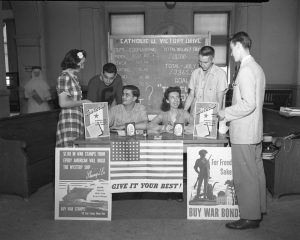
Despite the war ending in 1945, it would take several years for certain pre-war elements of campus life to return. For example, the Shahan Debating Society ceased operations during the war years and only returned in 1946. But other changes were fast and permanent. Women were more prevalent and active in the campus community. Not to mention, the G.I. Bill also led to an increased enrollment, dramatically ballooning the size of incoming classes. And with this increased enrollment came more and more new programs on the campus, from the School of Music to aerospace studies.
But students did not forget the war. Many of those present on the campus in the late 1940s and beyond were veterans. Memorials, both in print and in stone and wood, were established to remember the students and alumni who had passed away in the conflict.
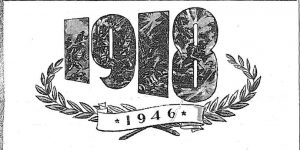
During a time of great upheaval and uncertainty, Cardinals expressed various emotions and turned to the past to understand present challenges. But once the initial shock wore off, members of the campus community rallied both on and off campus, finding ways to win the day and build a University community adapted to the times. While sacrifices were made, opportunities also arose as the campus emerged out of the war years having forged new ways forward. Out of the crucible of crisis, Catholic University’s students adapted and persevered.
